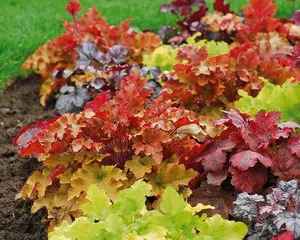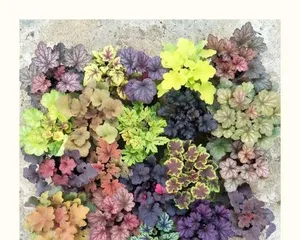Coleus is a highly ornamental plant, not only for its beautiful colorful leaves, but also because it can grow in all four seasons. However, in the cold winter, many people worry whether coleus can withstand the test of severe cold. This article will introduce you to the cold tolerance temperature and care tips for coleus, allowing you to easily master the secret of keeping coleus blooming with charming colors even in the cold winter.

I. What is Coleus
Coleus is a perennial herbaceous plant, a species of the genus Coleus in the Amaranthaceae family. It is commonly used as an ornamental plant in courtyards, flower beds, and potted plants. Its leaves come in various colors, including green, red, yellow, etc., and are very beautiful.
II. Cold Tolerance of Coleus
Coleus is a relatively cold-tolerant plant and can grow at lower temperatures. However, different varieties of coleus have different tolerances to low temperatures. Generally, the cold tolerance temperature of coleus is around zero degrees.

III. Winter Care Tips for Coleus
1. Ensure coleus gets enough sunlight
In winter, sunlight is scarce, so it is essential to ensure that coleus can grow in sufficient sunlight. If your coleus is grown indoors, it should be placed in a sufficiently bright location.
2. Keep the soil moist

Although the growth rate of coleus slows down in winter, it still needs sufficient water to grow. Therefore, you should keep the soil moist in winter. However, be careful not to overwater to avoid root rot.
3. Avoid wind chill
Coleus is a relatively cold-tolerant plant, but it is sensitive to wind chill. Therefore, in the cold winter, you should try to avoid exposing coleus to the wind, and you can choose to place it indoors or in a sheltered location.
4. Fertilize regularly
In winter, the growth rate of coleus slows down, but it still needs sufficient nutrients to grow. Therefore, in winter, you can fertilize coleus appropriately to ensure they get enough nutrients.
5. Prevent pests and diseases
In winter, coleus is susceptible to pests and diseases. Therefore, you should pay attention to observing the health status of coleus and regularly clean up pests and diseases.
IV. How to Choose the Right Coleus Variety
1. Red-leaved Coleus
Red-leaved coleus has very bright red leaves, which are very attractive in gardens and courtyards.
2. Golden-edged Coleus
The leaves of golden-edged coleus have golden-yellow edges, which are very beautiful. This type of coleus is very suitable for planting in flower beds and pots.
3. Green-leaved Coleus
The leaves of green-leaved coleus are emerald green, which is very refreshing. This type of coleus is often used for planting in courtyards and flower beds.
V. Propagation Methods for Coleus
Coleus can be propagated by two methods: division and cuttings. Division is to separate the roots of a mature coleus into several small roots and replant them in other locations. Cuttings involve cutting a stem from the coleus, inserting it into moist soil, and then waiting for it to root and grow into a seedling.
VI. How to Ensure Healthy Growth of Coleus in Summer
1. Keep the soil moist
The temperature is high in summer, and the soil can easily become dry. Therefore, in summer, you should water coleus frequently to keep the soil moist.
2. Provide shade
The sunlight is strong in summer, which can easily cause sunburn on coleus leaves. Therefore, in summer, you should provide some shade for coleus.
3. Fertilize regularly
In summer, coleus needs more nutrients to support its growth. Therefore, you should fertilize coleus regularly in summer.
VII. Common Diseases of Coleus
1. Powdery mildew
Powdery mildew is one of the common diseases of coleus, which causes white, powdery substances to appear on the leaves. The way to prevent powdery mildew is to regularly clean up fallen leaves and keep the plant ventilated.
2. Aphids
Aphids are one of the common pests of coleus. The way to prevent aphids is to regularly spray pesticides or use natural methods like soapy water to eliminate them.
3. Leaf spot disease
Leaf spot disease causes black spots to appear on coleus leaves. The way to prevent leaf spot disease is to regularly clean up fallen leaves and keep the plant ventilated.
VIII. Application Areas of Coleus
Coleus is commonly used as an ornamental plant in courtyards, flower beds, and potted plants. They can add color to courtyards and gardens, and can also be used as indoor decorations.
IX. How to Choose the Right Soil
Coleus likes moist, fertile, and well-drained soil. Therefore, when planting coleus, you should choose well-drained soil rich in organic matter.
X. How to Prune Coleus
Coleus does not need to be pruned frequently, but if the branches grow too densely, you can prune some branches appropriately to maintain its healthy growth.
XI. Habits of Coleus
Coleus likes a moist environment and plenty of sunlight, and has high requirements for soil and fertilization.
XII. Suitable Temperature for Coleus
The suitable growth temperature for coleus is between 15°C and 20°C. When the temperature is below 5°C, it may cause frost damage to coleus.
XIII. How to Transplant Coleus
When transplanting coleus, you need to dig out the roots completely and replant them in new soil. After transplanting, you need to pay attention to regular watering to ensure the growth of the plant.
XIV. How to Prevent Coleus from Dropping Leaves
Coleus leaf drop is usually caused by drought, lack of nutrients, or pests and diseases. Therefore, when planting coleus, you should pay attention to keeping the soil moist, fertilizing regularly, and cleaning up pests and diseases.
XV.
Coleus is a very beautiful ornamental plant with leaves of various colors. Although coleus is relatively cold-tolerant, it still needs to be cared for in winter to ensure its healthy growth. In addition, you also need to pay attention to pest and disease control, suitable soil, suitable temperature, etc. Only in this way can coleus display its beautiful colors in all four seasons.